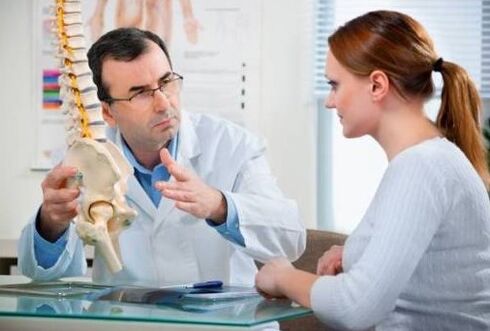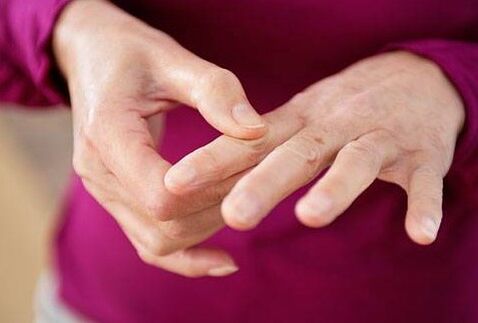Cervical osteochondrosis is developing more often in adults, but due to certain circumstances, a baby can occur. When a sign characteristic of such a disease appears, you should contact a therapist or a narrow profile specialist-a neurologist.

Degenerative-fatophic destruction of the cervical cervical disk of the spine characterizes the cervical osteochondrosis. Gradual progression of the disease leads to damage to intervertebral joints, adjacent vertebrae and ligament apparatus. Many mistakenly believe that osteochondrosis is the deposition of salts. However, such a statement is fundamentally wrong. Salt can really be deposited in different joints, but with other pathologies, for example, due to the development of gout.
Thanks to the muscle system, the spine of the human neck, consisting of seven beads. In this area, the muscles are poorly developed, due to which, due to long -term tension, fatigue occurs and spasms appear. In the future, the mobility of the cervical vertebrae becomes limited. As a result of this condition, the spine discs are gradually destroyed, which provokes the onset of the first phase of osteochondrosis. In the absence of treatment, the disease is constantly progressing, causing all the larger lesions of the spine. To prevent the development of complications, it is necessary to pay attention to the first signs of timely pathology and take appropriate measures.
Most often, people like cervical osteochondrosis face people whose lifestyle provides a minimum of physical activity and sedentary work. In such a person, with the most probability, the first features can already appear at the age of 25-30. Among children from baby to adolescence, the disease is less common, but it can also be due to an incorrect lifestyle or inheritance, other irritating factors.
Stages of development of pathology and their inherent symptoms
The whole process of developing osteochondrosis of the cervical back is divided into 4 main stages, each associated with certain symptoms. Treatment depends entirely on the severity of the disease. For example, the first, pre -clinical stage requires no drug treatment. To improve the patient's condition, it is recommended to radically review the lifestyle - perform physical exercises and eat properly. Characteristic features of this phase: excessive muscle tension of the whole back, the rapid appearance of a feeling of fatigue, a slight but vulnerable pain in moments of curves and tendencies. The main obstacle in this case can be distinguished that few people attach proper importance to such symptoms, so they do not immediately return to the hospital.

The following symptoms are characteristic of the second sea osteochondrosis:
All of the above symptoms cannot continue to pass unnoticed, therefore, for the most part, at this stage of the disease, the patient seeks medical help. Strengthening of pain is due to a decrease in the distance between the intervertebral discs and the nerve violation. An even greater deterioration of the situation occurs in the third phase. In this case, the neck pain constantly worries, the wrist muscles become very weak, occasionally, the numbness occurs. As for general symptoms, dizziness and weakness become the patient's daily friends. The cervical spine loses mobility.
Unbearable neck pain, shoulders, arms, ears in the ear, complete impaired coordination and the appearance of visible signs of other diseases indicates the beginning of the final, fourth phase of osteochondrosis. At the same time, the intervertebral discs are destroyed, and the pathological process moves further along the spine, affecting other departments. Such a degree of disease is difficult to treat, while surgical intervention may be necessary at the doctor's discretion. Thus, with the appearance of symptoms such as: neck pain and stalemate during head movements, hands, dizziness, nausea, headaches, hands, as well as fatigue and coordination problems should become an alarming signal that shows true health problems. Do not delay a visit to the doctor, it is best to contact a therapist or immediately to a neuropathologist.
In the process of progressing the cervical osteochondrosis, a spine violation may occur. Various sensitive and motor disorders may occur, depending on the back, which has suffered:

Prolonged ends of the vertebrae can squeeze the arteries through which the blood enters the brain. Thus, the bloodstream in the brain is disturbed and additional symptoms appear: a sharp change in mood, insomnia, anxiety without cause, fear, irritability. At the same time, with spasm of blood vessels, not only headaches, but also eye pain can occur. Patients often mark the appearance of "flies" in the eyes, sometimes dimming is possible.
Reasons for the development of cervical osteochondrosis
The most common cause of the occurrence of cervical osteochondrosis is considered to be a lifestyle sedentary about improper, unbalanced nutrition. Often, not only lazy people suffer from their nature, but also those whose profession forces most of the time to spend or in the same unpleasant position: office staff, vehicle drivers, etc. The emergence of degenerative processes in the discs is due to the violation of metabolic processes and blood circulation. Other reasons for the development of cervical osteochondrosis include:
Very diligent sport to play, which means very intense physical activity can also become the previous factor in cervical osteochondrosis. The primary disease under such conditions is most often a disk. The latter characterizes dystrophic disorders in intervertebral discs, mainly lumbar and cervical disputes. Osteochondrosis in this case is a consequence of a disk. In addition to excluding severe physical exercise, with this diagnosis, complex, drug and physiotherapeutic treatment is needed.

The consequences of progressive pathology
Among the complications that can occur with the development of osteochondrosis of the cervical region should be distinguished:
Cervical osteochondrosis always provokes an increase in blood pressure. Moreover, the passage of the underlying disease from one stage to another contributes to the progress of hypertension from the first degree to the third degree, in which the pressure exceeds the sign of 180 mm. Direct treatment hypertension helps to reduce the severity of the symptoms, but only temporarily. In case of curated osteochondrosis, it is impossible to get rid of increased blood pressure. In the case of a disk injury between the cervical vertebrae, as a complication, the periartrit occurs. It characterizes the tip of the nerves located in the connection of the shoulder fusion to the hand. At the same time, severe pain appears on the shoulder, having a negative effect on the mobility of all limbs. Also, manifestations of osteochondrosis cannot be based on signs of a heart disease, for example, angina pectoris, but thanks to diagnostic measures, it is possible to distinguish high accuracy diseases.
It is impossible to determine the osteochondrosis of the cervical spine by palpation and as a result of a visual medical examination. Based on the story collected, the doctor can only assume that exactly osteochondrosis became the cause of a certain symptoms. To confirm or refute such an assumption, the diagnosis is required. The most optimal way today is an MRI or magnetic resonance therapy. This method allows you to consider all bone structures, identify the presence of intervertebral hernia, the size of osteophytes and other characteristic complications of cervical osteochondrosis. Another way, a little less informative, is the calculated tomography. However, this allows you to create a diagnosis, determining the size of the hernia, as its presence can be difficult.

Treatment of cervical osteochondrosis
The treatment of osteochondrosis of the cervical region is always complex and complex. Its duration and saturation depends on the stage of development of the disease, the individual characteristics of the patient and the presence of other, accompanying diseases. Among the main groups of medicines, which are often prescribed in the second and further stages, should be distinguished:
The complex of these medicines is a symptomatic treatment. Compliance with all the doctor's recommendations and passing the certain course will help eliminate the pain and get rid of all the unpleasant manifestations of the disease. However, the therapeutic course does not end there. When the main characteristics are eliminated, which exacerbated the quality of life, you can take on the restoration of the cervical region in order to minimize the risk of restoring the disease in the near future. Unfortunately, a big mistake of many people is that after the disappearance of symptoms, they consider themselves completely healthy and abandon treatment. In this situation, osteochondrosis will certainly remember itself after a while.
Physiotherapy and traditional medicine
The following physiotherapeutic procedures are successfully used to treat cervical osteochondrosis:

Each of the above procedures has a number of contraindications, which is especially important for those who have an anamnesis of other diseases unrelated to the cervical spine osteochondrosis. The decision to suit the use of a particular method remains with the attending physician. It may not be safe to perform such measures of your free will. As for traditional medicine, you can use the grass of a saberfish, bran. Fig. It is also recommended to reduce salt intake. A responsible approach to the treatment of cervical osteochondrosis will make it possible to remove the disease with certainty. Let this process take a considerable time, but only complex therapy will reduce the new chance -the development of the disease to a minimum.

























